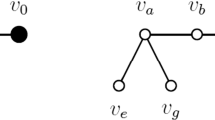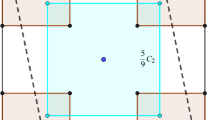Abstract
A set \(P = H \cup \{w\}\) of \(n+1\) points in general position in the plane is called a wheel set if all points but w are extreme. We show that for the purpose of counting crossing-free geometric graphs on such a set P, it suffices to know the frequency vector of P. While there are roughly \(2^n\) distinct order types that correspond to wheel sets, the number of frequency vectors is only about \(2^{n/2}\). We give simple formulas in terms of the frequency vector for the number of crossing-free spanning cycles, matchings, triangulations, and many more. Based on that, the corresponding numbers of graphs can be computed efficiently. In particular, we rediscover an already known formula for w-embracing triangles spanned by H. Also in higher dimensions, wheel sets turn out to be a suitable model to approach the problem of computing the simplicial depth of a point w in a set H, i.e., the number of w-embracing simplices. While our previous arguments in the plane do not generalize easily, we show how to use similar ideas in \(\mathbb {R}^d\) for any fixed d. The result is an \(O(n^{d-1})\) time algorithm for computing the simplicial depth of a point w in a set H of n points, improving on the previously best bound of \(O(n^d\log n)\). Based on our result about simplicial depth, we can compute the number of facets of the convex hull of \(n=d+k\) points in general position in \(\mathbb {R}^d\) in time \(O(n^{\max \{\omega ,k-2\}})\) where \(\omega \approx 2.373\), even though the asymptotic number of facets may be as large as \(n^k\).








Similar content being viewed by others
Notes
Here, \(\varphi (k)\) denotes Euler’s totient function, which counts the integers coprime to k that are at most k.
Sequence A007147 on OEIS (Online Encyclopedia of Integer Sequences).
Sequence A000016 on OEIS.
Sequence A001006 on OEIS.
Sequence A000108 on OEIS, which also counts abstract binary trees.
Sequence A001764 on OEIS, which, incidentally, also counts abstract ternary trees.
Sequence A006013 on OEIS, which also counts pairs of abstract ternary trees, implying the used identity since the left hand side is just the convolution of the counting sequence of abstract ternary trees.
The number \(\Box \) is also the number of crossings of the complete geometric graph on \(\widetilde{P}\), a quantity that has obtained special attention in connection with the so-called rectilinear crossing number of \(K_n\) (i.e., the smallest number of crossings in a straight line drawing of the complete graph in the plane).
For \(n = a_1 + a_2 + \dots + a_m\), we have \(\sum _{\{i,j,k\} \in {\left( {\begin{array}{c}[m]\\ 3\end{array}}\right) }} a_i a_j a_k = \frac{1}{6} \sum _{i=1}^m a_i (n-a_i) (n - 2a_i)\).
References
Ábrego, B.M., Fernández-Merchant, S.: A lower bound for the rectilinear crossing number. Graphs Comb. 21(3), 293–300 (2005)
Afshani, P., Sheehy, D.R., Stein, Y.: Approximating the simplicial depth (2015). arXiv:1512.04856
Aichholzer, O., Hackl, T., Huemer, C., Hurtado, F., Krasser, H., Vogtenhuber, B.: On the number of plane geometric graphs. Graphs Combin. 23(Supplement–1), 67–84 (2007)
Aigner, M.: Motzkin numbers. Eur. J. Combin. 19(6), 663–675 (1998)
Arkin, E.M., Khuller, S., Mitchell, J.S.B.: Geometric knapsack problems. Algorithmica 10(5), 399–427 (1993)
Becker, H.W.: Planar rhyme schemes. Bull. Am. Math. Soc. 58, 39 (1952)
Brouwer, A.E.: The enumeration of locally transitive tournaments. Technical Report Report ZW 138/80, Mathematisch Centrum, Amsterdam (1980)
Bürgisser, P., Lickteig, T., Clausen, M., Shokrollahi, A.: Algebraic Complexity Theory. Grundlehren der Mathematischen Wissenschaften. Springer, Berlin (1996)
Cheng, A.Y., Ouyang, M.: On algorithms for simplicial depth. In: Proceedings of the 13th Canadian Conference on Computational Geometry, pp. 53–56 (2001)
Dulucq, S., Penaud, J.-G.: Cordes, arbres et permutations. Discret. Math. 117(1), 89–105 (1993)
Dumitrescu, A., Schulz, A., Sheffer, A., Tóth, Cs.D.: Bounds on the maximum multiplicity of some common geometric graphs. SIAM J. Discret. Math. 27(2), 802–826 (2013)
Edelsbrunner, H., Mücke, E.P.: Simulation of simplicity: a technique to cope with degenerate cases in geometric algorithms. ACM Trans. Graph. 9(1), 66–104 (1990)
Edelsbrunner, H., O’Rourke, J., Seidel, R.: Constructing arrangements of lines and hyperplanes with applications. SIAM J. Comput. 15(2), 341–363 (1986)
Eppstein, D., Overmars, M.H., Rote, G., Woeginger, G.J.: Finding minimum area \(k\)-gons. Discrete Comput. Geom. 7(1), 45–58 (1992)
Flajolet, P., Noy, M.: Analytic combinatorics of non-crossing configurations. Discrete Math. 204(1–3), 203–229 (1999)
Gil, J., Steiger, W.L., Wigderson, A.: Geometric medians. Discrete Math. 108(1–3), 37–51 (1992)
Goodman, J.E., Pollack, R.: Multidimensional sorting. SIAM J. Comput. 12(3), 484–507 (1983)
Goodman, J.E., Pollack, R.: Semispaces of configurations, cell complexes of arrangements. J. Combin. Theory Ser. A 37(3), 257–293 (1984)
Grünbaum, B.: Convex Polytopes, 2nd edn. Springer, Berlin (2003)
Huemer, C., Pilz, A., Silveira, R.I.: A new lower bound on the maximum number of plane graphs using production matrices. In: Proceedings of the 34th European Workshop on Computational Geometry, pp. 9:1–9:6 (2018)
Hurtado, F., Noy, M.: Counting triangulations of almost-convex polygons. Ars Combin. 45, 169–179 (1997)
Khuller, S., Mitchell, J.S.B.: On a triangle counting problem. Inf. Process. Lett. 33(6), 319–321 (1990)
Linusson, S.: The number of \(M\)-sequences and \(f\)-vectors. Combinatorica 19(2), 255–266 (1999)
Liu, R.Y.: On a notion of data depth based on random simplices. Ann. Stat. 18(1), 405–414 (1990)
Lovász, L., Vesztergombi, K., Wagner, U., Welzl, E.: Convex quadrilaterals and \(k\)-sets. In: Pach, J. (ed.) Towards a Theory of Geometric Graphs. Contemporary Mathematics, vol. 342, pp. 139–148. American Mathematical Society, Providence (2004)
Matoušek, J.: Lectures on Discrete Geometry. Graduate Texts in Mathematics, vol. 212. Springer, New York (2002)
Montellano-Ballesteros, J.J., Strausz, R.: Counting polytopes via the Radon complex. J. Comb. Theory Ser. A 106(1), 109–121 (2004)
Motzkin, Th.: Relations between hypersurface cross ratios, and a combinatorial formula for partitions of a polygon, for permanent preponderance, and for non-associative products. Bull. Am. Math. Soc. 54(4), 352–360 (1948)
Palmer, E.M., Robinson, R.W.: Enumeration of self-dual configurations. Pac. J. Math. 110(1), 203–221 (1984)
Randall, D., Rote, G., Santos, F., Snoeyink, J.: Counting triangulations and pseudo-triangulations of wheels. In: Proceedings of the 13th Canadian Conference on Computational Geometry, pp. 149–152 (2001)
Rousseeuw, P.J., Ruts, I.: Bivariate location depth. J. R. Stat. Soc. Ser. C 45(4), 516–526 (1996)
Ruiz-Vargas, A.J., Welzl, E.: Crossing-free perfect matchings in wheel point sets. In: Loebl, M., Nešetřil, J., Thomas, R. (eds.) A Journey Through Discrete Mathematics: A Tribute to Jiří Matoušek, pp. 735–764. Springer, Cham (2017)
Sharir, M., Sheffer, A.: Counting triangulations of planar point sets. Electron. J. Comb. 18(1), Art. No. 70 (2011)
Sharir, M., Welzl, E.: On the number of crossing-free matchings, cycles, and partitions. SIAM J. Comput. 36(3), 695–720 (2006)
Sharir, M., Sheffer, A., Welzl, E.: Counting plane graphs: Perfect matchings, spanning cycles, and Kasteleyn’s technique. J. Comb. Theory Ser. A 120(4), 777–794 (2013)
Stolfi, J.: Oriented Projective Geometry. Academic Press, Boston (1991)
Wagner, U.: On the rectilinear crossing number of complete graphs. In: Proceedings of the 14th Annual Symposium on Discrete Algorithms, pp. 583–588. ACM/SIAM, San Diego (2003)
Wagner, U., Welzl, E.: A continuous analogue of the upper bound theorem. Discrete Comput. Geom. 26(2), 205–219 (2001)
Welzl, E.: Entering and leaving \({j}\)-facets. Discrete Comput. Geom. 25(3), 351–364 (2001)
Ziegler, G.M.: Lectures on Polytopes. Graduate Texts in Mathematics, vol. 152. Springer, New York (1995)
Acknowledgements
The first author acknowledges support by a Schrödinger fellowship of the Austrian Science Fund (FWF): J-3847-N35.
Author information
Authors and Affiliations
Corresponding author
Additional information
Editor in Charge: János Pach
Dedicated to the memory of Ricky Pollack.
Publisher's Note
Springer Nature remains neutral with regard to jurisdictional claims in published maps and institutional affiliations.
Rights and permissions
About this article
Cite this article
Pilz, A., Welzl, E. & Wettstein, M. From Crossing-Free Graphs on Wheel Sets to Embracing Simplices and Polytopes with Few Vertices. Discrete Comput Geom 64, 1067–1097 (2020). https://doi.org/10.1007/s00454-019-00147-1
Received:
Revised:
Accepted:
Published:
Issue Date:
DOI: https://doi.org/10.1007/s00454-019-00147-1




